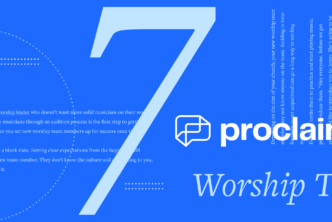By Amber Smith and Matthew Boffey
Social media for churches is about relationships. And just like any relationship, a little goes a long way—as long as the little is consistent.
Here are 10 easy wins for an effective social media presence.
1. Post once or twice a day.
The most important thing is that you do it. Posting once or twice a day keeps you consistent without over-posting and exhausting your audience. Try to post when people are likely scrolling, like first thing in the morning, during lunch, or just after work.
2. Share your events.
Since there’s no replacement for in-person community, prioritize events. Include a high-quality image that clearly explains the when, where, and what. You can share on Facebook or Faithlife (use the RSVP feature), as well as Instagram and Twitter—which allows your core community to spread the word, too.
3. Help people visit.
Make your church name and location clear and accessible on each platform. When people are looking for a church to attend, they’ll look on social media. Make sure they can find your service times and location quickly. If they have to search for too long, they’ll probably give up.
4. Use hashtags.
Think of hashtags as conversation topics. For example, use #womensretreat2022 in all your event promotion, and then encourage attendees to use it when they post on Instagram. At the end of the weekend, #womensretreat2022 essentially holds a photo album of memories and allows attendees to keep interacting. That’s relationship.
5. Have brand consistency.
Stick to a similar image style and theme in your content. When sharing sermon quotes, use the same style template for each image. When sharing events, use a similar format each time. Think of it like the style of a living room—one style, all the time.
6. Use Instagram Stories.
Many like to use this feature to be relatable and slightly more casual in voice and tone. With all the options to add text and stickers, you can play around with making it unique. Share about the different ministries in your church, or give a shout-out to a specific member.
7. Get design help.
There are so many helpful options out there to get you up and running. With tools like Canva, Crello, Snappa, and many others, you can customize images and create beautiful pieces of content that match the branding of your church.
8. Schedule your posts.
Make a list of all the content ideas you have and find strategic places to add them to the calendar. Account for the rhythm of the seasons. During busy times like Christmas and Easter, promote your events. During downtime, post engaging questions or quotes.
9. Respond.
Since the point of social media is building relationships, one of the most important things you can do is respond. Whether the comment is positive, negative, or neutral, responding is the best way to keep the engagement going. It also shows that your church is active, available, and caring.
10. Share the love.
Reshare local events, interesting articles, or content from other ministries and churches. This shows that you’re a team player and broadens your reach. It allows new people to see your content—which could be their first opportunity to hear about your church.
***
Want to develop your church’s social media policy or plans? You can download a free social media template, or check out what other churches and denominations are doing for inspiration.
This article on social media for churches is adapted from the February 2020 edition of Ministry Team magazine.





